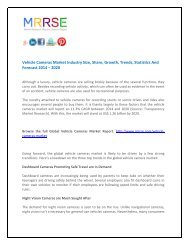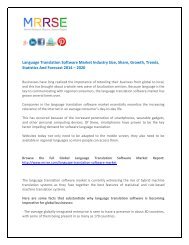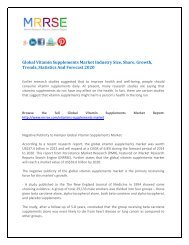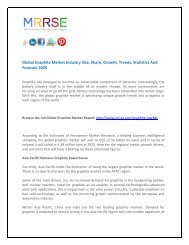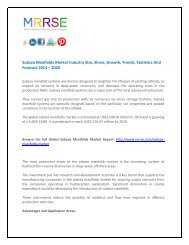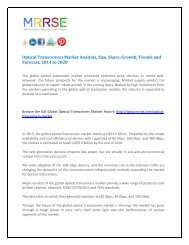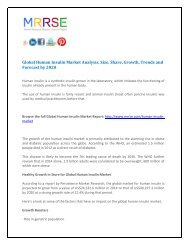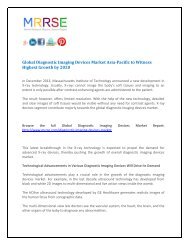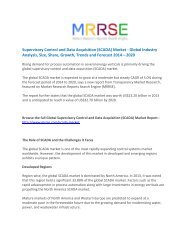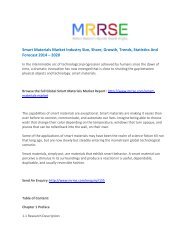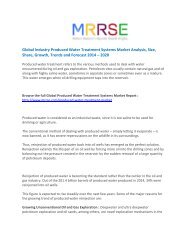Global Foam Blowing Agents Market New Generation Foam Blowing Agents to Define the Future.pdf
MRRSE.Com announces addition of new report"Global Foam Blowing Agents Market An analysis of the digital, mobile and social media landscape"to its database
MRRSE.Com announces addition of new report"Global Foam Blowing Agents Market An analysis of the digital, mobile and social media landscape"to its database
You also want an ePaper? Increase the reach of your titles
YUMPU automatically turns print PDFs into web optimized ePapers that Google loves.
<strong>Global</strong> <strong>Foam</strong> <strong>Blowing</strong> <strong>Agents</strong> <strong>Market</strong> <strong>New</strong> <strong>Generation</strong> <strong>Foam</strong> <strong>Blowing</strong> <strong>Agents</strong> <strong>to</strong><br />
<strong>Define</strong> <strong>the</strong> <strong>Future</strong><br />
Increased demand for foam blowing agents across various industries such as refrigeration,<br />
au<strong>to</strong>motive, construction, and manufacturing is expected <strong>to</strong> push <strong>the</strong> growth of <strong>the</strong> global<br />
foam blowing agents market at a CAGR of 4.4% during <strong>the</strong> period from 2013 <strong>to</strong> 2020.<br />
Traditionally, hydrocarbons (HC), hydrofluorocarbons (HFC), hydrochloroflourocarbons (HCFC)<br />
along with products such as hydrazine, azodicarbonamide, and CO2 have been used as key<br />
foam blowing agents.<br />
After <strong>the</strong> Montreal Pro<strong>to</strong>col and Kyo<strong>to</strong> Pro<strong>to</strong>col came in<strong>to</strong> force <strong>to</strong> reduce <strong>the</strong> production and<br />
consumption of HC, HFC, and HCFC due <strong>to</strong> <strong>the</strong>ir negative impact on earth’s ozone layer,<br />
industry players have been looking out for alternative eco-friendly foam blowing agents.<br />
Browse <strong>the</strong> full <strong>Global</strong> <strong>Foam</strong> <strong>Blowing</strong> <strong>Agents</strong> <strong>Market</strong> Report : http://www.mrrse.com/foamblowing-agents-market<br />
The environmental impact of substitute foam blowing agents is judged by <strong>the</strong>ir ozone<br />
depletion potential (ODP), and global warming potential (GWP).<br />
The U.S. Environmental Protection Agency (EPA) evaluates and lists <strong>the</strong> various substitute<br />
foam blowing agents under its Significant <strong>New</strong> Alternatives Policy (SNAP) program. Taking cue<br />
from <strong>the</strong> EPA’s list of substitute foam blowing agents, manufacturers are now focusing on<br />
developing foam blowing agents with low GWP.<br />
Key Industry Players Developing <strong>Foam</strong> <strong>Blowing</strong> <strong>Agents</strong> with Lower GWP<br />
Contributing <strong>to</strong> <strong>the</strong> cause of reducing ozone depletion and global warming, Honeywell<br />
International has developed Solstice Liquid <strong>Blowing</strong> Agent (LBA), which is <strong>the</strong> latest foam<br />
blowing agent technology.
The nonflammable and cost-effective blowing agent has a GWP of 1, which is way lower than<br />
that of <strong>the</strong> o<strong>the</strong>r commonly used HFCs such as cyclopentane, HFC-245fa, HFC-365mfc, and<br />
methyl formate.<br />
The product is a fourth-generation foam blowing agent developed by <strong>the</strong> company and has<br />
been included in <strong>the</strong> SNAP list as a suitable alternative in all foam applications.<br />
France’s leading chemicals manufacturer, Arkema, has developed <strong>the</strong> liquid blowing agent<br />
Forane 1233zd with a GWP of 7, which outperforms HFCs in terms of energy efficiency and<br />
vapor pressure. Similarly, DuPont Chemicals & Fluoroproducts has introduced Formacel 1100<br />
as a next-generation foam expansion agent. Formacel 1100 has a GWP of 2 and a zero ODP.<br />
Browse <strong>the</strong> full Press Release of <strong>Foam</strong> <strong>Blowing</strong> <strong>Agents</strong> <strong>Market</strong> :<br />
http://www.mrrse.com/foam-blowing-agents-market-report<br />
Developing Nations Adopting Low-GWP Alternatives<br />
<strong>Foam</strong> blowing agents are majorly used in <strong>the</strong> building and construction industry.<br />
It was estimated by <strong>the</strong> U.S. EPA that <strong>the</strong> overall HFC consumption in <strong>the</strong> construction foams<br />
sec<strong>to</strong>r was around 38 million metric <strong>to</strong>ns of carbon dioxide equivalent in 2010. Developed<br />
countries held a majority share in <strong>the</strong> <strong>to</strong>tal HFC consumption in 2010.<br />
As industry players develop low-GWP alternatives, it is expected that HFCs and HCFCs will be<br />
gradually phased out of <strong>the</strong> market. In developing economies, efforts have been taken <strong>to</strong><br />
increase <strong>the</strong> adoption of low-GWP alternatives.<br />
In Brazil, methylal is being used for <strong>the</strong> production of spray, panels, block, and pipe-in-pipe<br />
foam. Usage of super-critical CO2 in manufacturing of spray foam is being encouraged in<br />
Colombia. With growing awareness about <strong>the</strong> adverse impacts of global warming and industry<br />
players coming up with eco-friendly alternatives, <strong>the</strong> carbon footprint of <strong>the</strong> foam blowing<br />
agents market is expected <strong>to</strong> decrease in <strong>the</strong> near future.<br />
Send An Enquiry: http://www.mrrse.com/enquiry/153
Table of Contents:<br />
Chapter 1 Preface<br />
1.1 Report Description<br />
1.2 <strong>Market</strong> Segmentation<br />
1.3 Research Scope and Assumptions<br />
1.3.1 Research Scope<br />
1.3.2 Assumptions<br />
1.3.3 Abbreviations<br />
1.4 Research Methodology<br />
Chapter 2 Executive Summary<br />
2.1 <strong>Global</strong> <strong>Foam</strong> <strong>Blowing</strong> <strong>Agents</strong> <strong>Market</strong>, 2013 – 2020 (Kilo Tons) (US$ Mn)<br />
2.1.1 <strong>Global</strong> <strong>Foam</strong> <strong>Blowing</strong> <strong>Agents</strong> <strong>Market</strong> Snapshot, 2013 and 2020<br />
Chapter 3 <strong>Foam</strong> <strong>Blowing</strong> <strong>Agents</strong> - Industry Analysis<br />
3.1 Introduction<br />
3.2 Value Chain Analysis<br />
3.3 <strong>Market</strong> Drivers<br />
3.3.1 Increasing demand for foam blowing agents for polyurethane foam manufacturing<br />
3.3.1.1 <strong>Global</strong> Polyurethane <strong>Foam</strong>s <strong>Market</strong> Revenue, 2009 - 2020 (US$ Bn)<br />
3.3.2 Rising demand for polymeric foams from <strong>the</strong> construction industry<br />
3.3.2.1 World Construction <strong>Market</strong> Revenue, 2010 - 2020 (US$ Trn)<br />
3.3.2.2 Construction <strong>Market</strong> Revenue Share, by Region, 2020 (%)
3.4 <strong>Market</strong> Restraints<br />
3.4.1 Environmental regulations against harmful foam blowing agents<br />
3.4.2 Volatility in crude oil prices puts pressure on <strong>the</strong> manufacturers’ margins<br />
3.4.2.1 <strong>Global</strong> Crude Oil Prices, 2008–2015 (US$/Barrel)<br />
3.5 Opportunities<br />
3.5.1 Development and commercialization of low GWP and low ODP, eco-friendly foam<br />
blowing agents<br />
3.6 Porter’s Five Forces Analysis<br />
3.6.1 Bargaining power of suppliers<br />
3.6.2 Bargaining power of buyers<br />
3.6.3 Threat from substitutes<br />
3.6.4 Threat of new entrants<br />
3.6.5 Degree of competition<br />
3.7 <strong>Foam</strong> <strong>Blowing</strong> <strong>Agents</strong>: <strong>Market</strong> Attractiveness Analysis<br />
Chapter 4 <strong>Foam</strong> <strong>Blowing</strong> <strong>Agents</strong> <strong>Market</strong> – Product Segment Analysis<br />
4.1 <strong>Global</strong> <strong>Foam</strong> <strong>Blowing</strong> <strong>Agents</strong> <strong>Market</strong> - Product Segment Overview<br />
4.1.1 <strong>Global</strong> <strong>Foam</strong> <strong>Blowing</strong> <strong>Agents</strong> <strong>Market</strong> Volume Share, by Product Segments, 2013 and<br />
2020 (%)<br />
4.2 Hydrocarbons (HC)<br />
4.2.1 <strong>Global</strong> HC <strong>Foam</strong> <strong>Blowing</strong> <strong>Agents</strong> <strong>Market</strong>, 2013 - 2020 (Kilo Tons) (US$ Mn)<br />
4.3 Hydrofluorocarbons (HFC)<br />
4.3.1 <strong>Global</strong> HFC <strong>Foam</strong> <strong>Blowing</strong> <strong>Agents</strong> <strong>Market</strong>, 2013 - 2020 (Kilo Tons) (US$ Mn)<br />
4.4 Hydrochlorofluorocarbons (HCFC)
4.4.1 <strong>Global</strong> HCFC <strong>Foam</strong> <strong>Blowing</strong> <strong>Agents</strong> <strong>Market</strong>, 2013 - 2020 (Kilo Tons) (US$ Mn)<br />
4.5 O<strong>the</strong>rs<br />
4.5.1 <strong>Global</strong> O<strong>the</strong>r <strong>Foam</strong> <strong>Blowing</strong> <strong>Agents</strong> <strong>Market</strong>, 2013 - 2020 (Kilo Tons) (US$ Mn)<br />
Capter 5 <strong>Foam</strong> <strong>Blowing</strong> <strong>Agents</strong> <strong>Market</strong> – Application Analysis<br />
5.1 <strong>Global</strong> <strong>Foam</strong> <strong>Blowing</strong> <strong>Agents</strong> <strong>Market</strong> - Application Overview<br />
5.1.1 <strong>Global</strong> <strong>Foam</strong> <strong>Blowing</strong> <strong>Agents</strong> <strong>Market</strong> Volume Share, by Application, 2013 and 2020 (%)<br />
5.2 Polyurethane (PU) <strong>Foam</strong>s<br />
5.2.1 <strong>Global</strong> <strong>Foam</strong> <strong>Blowing</strong> <strong>Agents</strong> <strong>Market</strong> for PU <strong>Foam</strong>s, 2013 - 2020 (Kilo Tons) (US$ Mn)<br />
5.3 Polystyrene (PS) <strong>Foam</strong>s<br />
5.3.1 <strong>Global</strong> <strong>Foam</strong> <strong>Blowing</strong> <strong>Agents</strong> <strong>Market</strong> for PS <strong>Foam</strong>s, 2013 - 2020 (Kilo Tons) (US$ Mn)<br />
5.4 Polyolefin <strong>Foam</strong>s<br />
5.4.1 <strong>Global</strong> <strong>Foam</strong> <strong>Blowing</strong> <strong>Agents</strong> <strong>Market</strong> for Polyolefin <strong>Foam</strong>s, 2013 - 2020 (Kilo Tons) (US$<br />
Mn)<br />
5.5 O<strong>the</strong>rs<br />
5.5.1 <strong>Global</strong> <strong>Foam</strong> <strong>Blowing</strong> <strong>Agents</strong> <strong>Market</strong> for O<strong>the</strong>r <strong>Foam</strong> Applications, 2013 - 2020 (Kilo<br />
Tons) (US$ Mn)<br />
Chapter 6 <strong>Global</strong> <strong>Foam</strong> <strong>Blowing</strong> <strong>Agents</strong> <strong>Market</strong> - Regional Analysis<br />
6.1 <strong>Global</strong> <strong>Foam</strong> <strong>Blowing</strong> <strong>Agents</strong> <strong>Market</strong> - Regional Overview<br />
6.1.1 <strong>Global</strong> <strong>Foam</strong> <strong>Blowing</strong> <strong>Agents</strong> <strong>Market</strong> Volume Share by Region, 2013 and 2020 (%)<br />
6.2 North America<br />
6.2.1 North America <strong>Foam</strong> <strong>Blowing</strong> <strong>Agents</strong> <strong>Market</strong> Volume, by Products, 2013 - 2020 (Kilo<br />
Tons)
6.2.2 North America <strong>Foam</strong> <strong>Blowing</strong> <strong>Agents</strong> <strong>Market</strong> Revenue, by Products, 2013 - 2020 (US$<br />
Mn)<br />
6.2.3 North America <strong>Foam</strong> <strong>Blowing</strong> <strong>Agents</strong> <strong>Market</strong> Volume, by Application, 2013 - 2020 (Kilo<br />
Tons)<br />
6.2.4 North America <strong>Foam</strong> <strong>Blowing</strong> <strong>Agents</strong> <strong>Market</strong> Revenue, by Application, 2013 - 2020 (US$<br />
Mn)<br />
6.3 Europe<br />
6.3.1 Europe <strong>Foam</strong> <strong>Blowing</strong> <strong>Agents</strong> <strong>Market</strong> Volume, by Products, 2013 - 2020 (Kilo Tons)<br />
6.3.2 Europe <strong>Foam</strong> <strong>Blowing</strong> <strong>Agents</strong> <strong>Market</strong> Revenue, by Products, 2013 - 2020 (US$ Mn)<br />
6.3.3 Europe <strong>Foam</strong> <strong>Blowing</strong> <strong>Agents</strong> <strong>Market</strong> Volume, by Application, 2013 - 2020 (Kilo Tons)<br />
6.3.4 Europe <strong>Foam</strong> <strong>Blowing</strong> <strong>Agents</strong> <strong>Market</strong> Revenue, by Application, 2013 - 2020 (US$ Mn)<br />
6.4 Asia Pacific<br />
6.4.1 Asia Pacific <strong>Foam</strong> <strong>Blowing</strong> <strong>Agents</strong> <strong>Market</strong> Volume, by Products, 2013 - 2020 (Kilo Tons)<br />
6.4.2 Asia Pacific <strong>Foam</strong> <strong>Blowing</strong> <strong>Agents</strong> <strong>Market</strong> Revenue, by Products, 2013 - 2020 (US$ Mn)<br />
6.4.3 Asia Pacific <strong>Foam</strong> <strong>Blowing</strong> <strong>Agents</strong> <strong>Market</strong> Volume, by Application, 2013 - 2020 (Kilo<br />
Tons)<br />
6.4.4 Asia Pacific <strong>Foam</strong> <strong>Blowing</strong> <strong>Agents</strong> <strong>Market</strong> Revenue, by Application, 2013 - 2020 (US$ Mn)<br />
6.5 Rest of <strong>the</strong> World (RoW)<br />
6.5.1 RoW <strong>Foam</strong> <strong>Blowing</strong> <strong>Agents</strong> <strong>Market</strong> Volume, by Products, 2013 - 2020 (Kilo Tons)<br />
6.5.2 RoW <strong>Foam</strong> <strong>Blowing</strong> <strong>Agents</strong> <strong>Market</strong> Revenue, by Products, 2013 - 2020 (US$ Mn)<br />
6.5.3 RoW <strong>Foam</strong> <strong>Blowing</strong> <strong>Agents</strong> <strong>Market</strong> Volume, by Application, 2013 - 2020 (Kilo Tons)<br />
6.5.4 RoW <strong>Foam</strong> <strong>Blowing</strong> <strong>Agents</strong> <strong>Market</strong> Revenue, by Application, 2013 - 2020 (US$ Mn)<br />
Chapter 7 Company Profiles<br />
7.1 Arkema SA
7.2 Exxon Mobil Corporation<br />
7.3 Solvay S.A. (Solvay)<br />
7.4 Honeywell International Inc. (Honeywell)<br />
7.5 E.I. du Pont de Nemours and Company (DuPont)<br />
7.6 Akzo Nobel NV<br />
7.7 Daikin Industries, Ltd. (Daikin)<br />
7.8 Haltermann GmBH<br />
7.9 Sinochem Group<br />
7.10 ZEON Corporation<br />
Latest Report:<br />
Sulfur Chemicals <strong>Market</strong> - <strong>Global</strong> Industry Expert Opinions Analysis, Emerging<br />
Opportunities, <strong>Market</strong> Size, Share, Growth Drivers, <strong>Market</strong> Trends, Statistics And Forecast<br />
2015 – 2020<br />
http://www.mrrse.com/sulfur-chemicals-market<br />
Description:<br />
Sulfur is one <strong>the</strong> most important raw material of <strong>the</strong> chemical industry.<br />
Majority of sulfur is used in preparation of its derivatives such as sulfuric acid, sodium hydro<br />
sulfide, sodium hydrosulfite, sodium sulfite, sodium sulfide and sodium thiosulfate. Sodium<br />
sulfites include dry and liquid sodium sulfite, sodium bisulfate solution and sodium<br />
metabisulfite.<br />
These chemicals are majorly used in applications like paper, pulp and textile processing, food<br />
and pho<strong>to</strong>graphic industries and in water treatment as reducing and precipitating agent.<br />
Hydrogen Cyanide <strong>Market</strong> - <strong>Global</strong> Industry Expert Opinions Analysis, Emerging<br />
Opportunities, <strong>Market</strong> Size, Share, Growth Drivers, <strong>Market</strong> Trends, Statistics And Forecast<br />
2015 – 2020
http://www.mrrse.com/hydrogen-cyanide-market<br />
Hydrogen cyanide is also known as prussic acid. Hydrogen cyanide is an inorganic compound<br />
that is colorless in nature. Hydrogen cyanide is extremely poisonous liquid which boils at <strong>the</strong><br />
slightly above room temperature.<br />
Hydrogen cyanide is weakly acidic and partially ionizes in <strong>the</strong> water solutions <strong>to</strong> form cyanide<br />
ions. Hydrogen cyanide has a faint, bitter, almond like smell that sometimes is undetected.<br />
Hydrogen cyanide is usually manufactured in large quantities at an industrial scale.<br />
Hydrogen cyanide is an essential and highly valuable precursor for <strong>the</strong> manufacturing of a<br />
range of chemical compounds from polymers <strong>to</strong> that of pharmaceuticals. Hydrogen cyanide is<br />
included among <strong>the</strong> chemical welfare (CW) list of chemicals that are known <strong>to</strong> be poisonous in<br />
nature.<br />
About Us:<br />
<strong>Market</strong> Research Reports Search Engine (MRRSE) is an industry-leading database of market<br />
intelligence reports.<br />
Headquartered in <strong>New</strong> York, U.S., MRRSE is driven by a stellar team of research experts and<br />
advisors trained <strong>to</strong> offer objective advice.<br />
Our sophisticated search algorithm returns results based on <strong>the</strong> report title, geographical<br />
region, publisher, or o<strong>the</strong>r keywords.<br />
MRRSE partners exclusively with leading global publishers <strong>to</strong> provide clients single-point<br />
access <strong>to</strong> <strong>to</strong>p-of-<strong>the</strong>-line market research. MRRSE’s reposi<strong>to</strong>ry is updated every day <strong>to</strong> keep its<br />
clients ahead of <strong>the</strong> next new trend in market research, be it competitive intelligence, product<br />
or service trends or strategic consulting.<br />
Contact<br />
State Tower<br />
90, State Street<br />
Suite 700
Albany, NY - 12207<br />
United States<br />
Telephone: +1-518-618-1030<br />
Email: sales@mrrse.com<br />
Website: http://www.mrrse.com/



